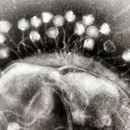BRCA Gene Test, Bacteriophages, Synesthesia. March 9, 2018, Part 1
Overuse of antibiotics has lead to bacteria becoming resistant to the drugs. In the United States, at least two million people become infected with antibiotic resistant bacteria each year, according to the Center for Disease Control. While some researchers are looking for new sources of antibiotics, other scientists are looking for new strategies to treat bacterial infections. One strategy is the use of bacteriophages—viruses that infect and kill bacteria.
In 2013, the Food and Drug Administration prohibited the consumer genetic testing company 23andMe from marketing a test for breast cancer mutations and drug sensitivity. Now, the FDA has changed its mind, granting 23andMe permission to screen for three mutations in the BRCA1 and BRCA2 genes, which increase breast cancer risk.
Around four percent of the world’s population has some form of synesthesia, a neurological phenomenon that blurs some of the lines around the senses. In two of the more common variants, synesthetes may involuntarily associate letters with colors, or see colors for musical notes—but there are many other forms of synesthesia, all involving the crossover of one form of perception to another. This week, researchers report that they’ve identified several regions of the genome that may be involved in synesthesia.
Plus, Maggie Koerth-Baker, senior science reporter for Fivethirtyeight.com, tells Ira about a falling space station, exoplanets, and more top science stories of the week in the News Round-up.
